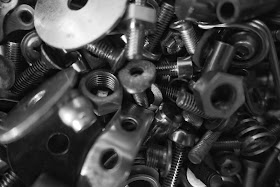By Scott
When I went to school, it was mandatory to take a variety of shop/home economics classes in grade 8. Both boys and girls took classes in woodworking, cooking, sewing, metal working and electrical work in order to introduce us to different trade opportunities and ensure that each of us could do basic sewing and cooking at home. This was where I first heard the term, measure twice, cut once. Now having gone on from the workshops of Hugh Boyd Jr Secondary to working in a bike shop of 900 sq feet, to cutting aluminium and plastic for a folding kayak maker, to fixing my bikes and my wife's bike over the years, I've picked up a couple of things.
When it comes to cutting things, always measure at least twice. Preferably, use metric measurements to determine the length of things. Math was always a failing of mine, so an imperial tape measure brings on anxiety. The tape measure I use here at work is a cloth one from a fabric shop that has metric on one side and imperial on another. This way if someone calls and says they measured X and it is 20 1/4", I can find that on one side and flip it over to see what the metric equivalent is (51.4 cm FYI). See, tricks of the trade already.
If you are going to error in terms of cutting, always cut on the outside of the line. That way, if you are a hair long, you can file/shave down the item. With things like steerer tubes or fender stays, no matter how far you bury them in the ground and provide nutrients, you can't make them grow longer once they're cut. So err slightly to the long side if you have to.
Always have a cup of tea or coffee on hand to sip on while taking measurements and cutting. The act of reaching and sipping gives one time to think about what we're doing and determine if we really did do the math right for calculating the mechanical advantage of the Zeste Brakes I'm installing.
Also, know where to find spares of stuff. Our most common spare parts are for fenders. In fact, we have a whole section of just accessories and hardware to help folks out if they have somehow lost something or as is the case often with stays, cut them down for one size tire/wheel, but now want to move the fender to a new bike or put on larger tires. then you need longer stays. The stays themselves are all the same length, 40 cm from the apex to the tip. The width of the curve where they go over the fender is where they vary.
We also sell bolts for rack and for bottle cage attachment. We have housing caps for older French and Italian bikes that use 4 mm cable stops, when all the modern cables are 5 mm. Having an easy to find container or box to put all the backup parts also helps. I keep a bin at work that is properly labeled so that other folks can find small parts that I've put aside for just "that" occasion. Toss stuff into a little zip loc (you can even write on the outside with a sharpie if you want to keep it even easier to keep track of) and voila, a little box of bits that you'll always find handy.
What sort of small bits are you constantly looking for?




To go along with the "no matter how many times you cut it, it only gets shorter" thought, there is "no matter how many times you drill it, it only gets bigger." One of our quality control guys used to say "step back and take a deep breath." Same benefits as your reach and sip.
ReplyDeleteBe careful with those cloth tape measures from fabric stores. They can s-t-r-e-t-c-h over time with use. Then your measurements are no longer accurate. I know this from experience ;-)
ReplyDelete